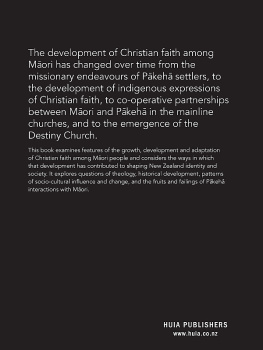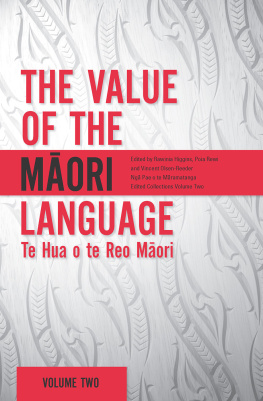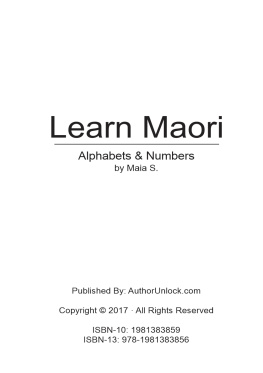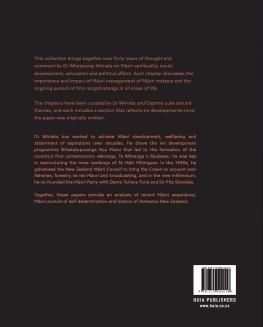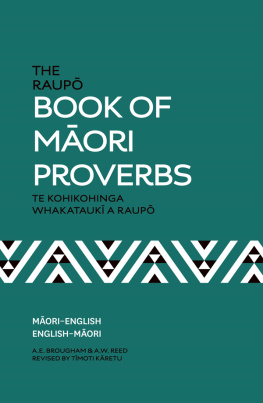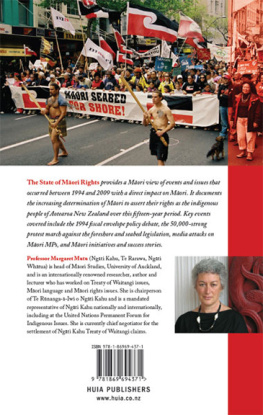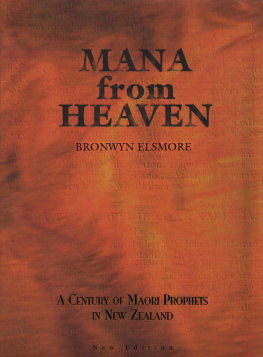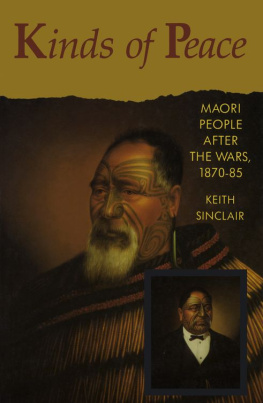First published in 2011 by Huia Publishers
39 Pipitea Street, PO Box 17335
Wellington, Aotearoa New Zealand
www.huia.co.nz
ISBN 978-1-77550-023-0
Copyright the authors 2011
This book is copyright. Apart from fair dealing for the purpose of private study, research, criticism or review, as permitted under the Copyright Act, no part may be reproduced
by any process without the prior permission of the publisher.
Ebook production 2012 by meBooks
National Library of New Zealand Cataloguing-in-Publication Data
Mori and social issues / edited by Tracey McIntosh and
Malcolm Mulholland.
(Ng Pae o te Mramatanga edited collections; v. 1)
Includes bibliographical references and index.
ISBN 978-1-77550-023-0
1. Maori (New Zealand people)Social conditions. 2. New Zealand
Social conditions21st century. [1. huatanga ppori. reo
2. Tngata. reo] I. McIntosh, Tracey. II. Mulholland, Malcolm, 1976-
III. Ng Pae o te Mramatanga (Organization). IV. Series.
305.899442dc 22
Published with the assistance of Ng Pae o te Mramatanga
This book is the first in the series of Ng Pae o te Mramatanga Edited Collections.
Ng Pae o te Mramatanga is New Zealands Indigenous Centre of Research Excellence, funded by the Tertiary Education Commission and hosted by The University of Auckland.
Preface
Te Ahukaram Charles Royal
Director, Ng Pae o te Mramatanga
During the course of the nineteenth century, a new people emerged in our country, a group who were to become known in the present day as Mori. Comprising the aboriginal inhabitants of Aotearoa New Zealand at the time of European arrival, this new collectivity and identity arose primarily through the period of European colonisation. Since that time it has become usual for us to refer to a people in this country as Mori and yet one may wonder how meaningful the identity called Mori really was and is. For example, my Ngti Raukawa and Ngti Toarangatira ancestors migrated to the southern reaches of the North Island and the northern reaches of the South Island in the early decades of the nineteenth century. In doing so, they came into conflict with the Kurahaup peoples who were living there at the time.
When 1840 arrived and the identity called Mori began to emerge, one wonders how acceptable it would have been to the Kurahaup peoples to now be grouped into a new identity called Mori, a grouping which included my ancestors with whom they were in conflict. I suspect that it was only meaningful when these peoples were speaking in contrast or directly to the equally new identity called Pkeh.
Feeling the full onslaught of European arrival, the quest for some kind of pan-Mori unity grew expressed in such initiatives as the King Movement, the Kotahitanga Parliaments, the Young Mori Party and the Rtana Church. It is significant that, despite these substantial initiatives, such unity has never been finally achieved, suggesting a diversity greater than that symbolised by the word Mori.
Ought we to be surprised by this? I think not. It is a modern misunderstanding that suggests in an absolute and comprehensive way that there is a homogenous and unified Mori people. Indeed, there is a Mori people but the boundaries are porous and the picture is rich and complex. The foundations of the contemporary Mori world are the many iwi, hap and whnau found throughout the country, complicated yet further by experiences of urbanisation and the increasing diversity in our genealogies. If we were to trace the experiences and lifeways of all the descendants of the aboriginal inhabitants of this land at the time of European arrival, the picture would be rich, diverse and complicated.
Of course, it is possible to suggest that today Mori is meaningful because of the incidence of certain kinds of social experiences and issues that distinctively occur or feature in this group. Considerable effort has been exerted to identify those social experiences (health disparities, for example) which occur in certain unique ways in the Mori population. A secondary question relates to the degree to which these issues and challenges have arisen as a consequence of historical factors, particularly those which arose during European colonisation of Aotearoa New Zealand. We can ask to what degree can the disparities and challenges facing Mori today be attributed (partially at least) to experiences of colonisation, including land loss, fragmentation of families and community and cultural loss leading to poverty and impoverishment?
The Mori people remain today. For better or for worse, Mori is a distinctive identity and people in our nation, despite its imperfections as a way of labelling and identifying these people. This volume contains contributions concerning various social issues as they affect Mori people. It is the first of a planned series of edited collections on various topics by Ng Pae o te Mramatanga. A Centre of Research Excellence, our mission is to conduct excellent research designed to engage the creative potential of Mori communities to create positive change and transformation. We commission research which addresses needs and opportunities arising in those communities. This volume is an overview of some of the social issues and needs arising in those communities and how they might be addressed. By no means the last word, this volume represents an opportunity to provide an overview of social issues and how they affect Mori.
Editors Acknowledgements
We would like to begin by thanking all the authors that have contributed to this collection. Ng Pae o te Mramatanga values our ongoing relationship with this group of researchers. The commitment of the authors to their research areas and, most importantly, to the Mori communities that they serve is apparent in all their work.
We would like to acknowledge the Sociology Department of The University of Auckland for their support and the role that a number of colleagues played in reviewing chapters, providing helpful criticisms and suggestions. I would particularly like to thank Leon Radojkovic, Adam Craigie and Dominic Andrae for research assistance. Steve Matthewman played a special role in giving both valuable academic guidance as well as personal support.
We are indebted to the significant contribution and support that Helen Ross, Ng Pae o te Mramatanga Publications Manager, has given to the editors. Calm and assured and much appreciated. Finally, we would like to thank Matthew Bauer for his work proofreading the final manuscript.
Introduction
Tracey McIntosh
This book is the first of a series of edited collections that will look at Mori research in areas that are critical for Mori and for broader society. This volume canvases a range of social issues that are significant for a better understanding of the experience and social environment of Mori, and important in that they highlight the need to ensure research-based solutions to these issues. The majority of these chapters deal with social problems. However, this book is not a call to a return of deficit research. Rather it is an opportunity to collectively provide power-centred, Mori-centred perspectives and solutions.
While the chapters are comprehensive, the topics covered in this first collection are not exhaustive. Gaps are acknowledged. Areas of critical importance such as housing, unemployment and youth related issues are not to be found in this volume. Their absence is explained by a number of reasons: it could be as simple as a researcher not being well placed to meet a publishing deadline or it could be due to the difficulties of locating Mori doing research in particular areas. Subsequent edited collections will bridge some of these gaps. One will look at life course research. Another will be a companion to this collection, looking at other social issues. We need to recognise that there are areas that still need better Mori research capability to ensure that excellent Mori-centred research is produced.



